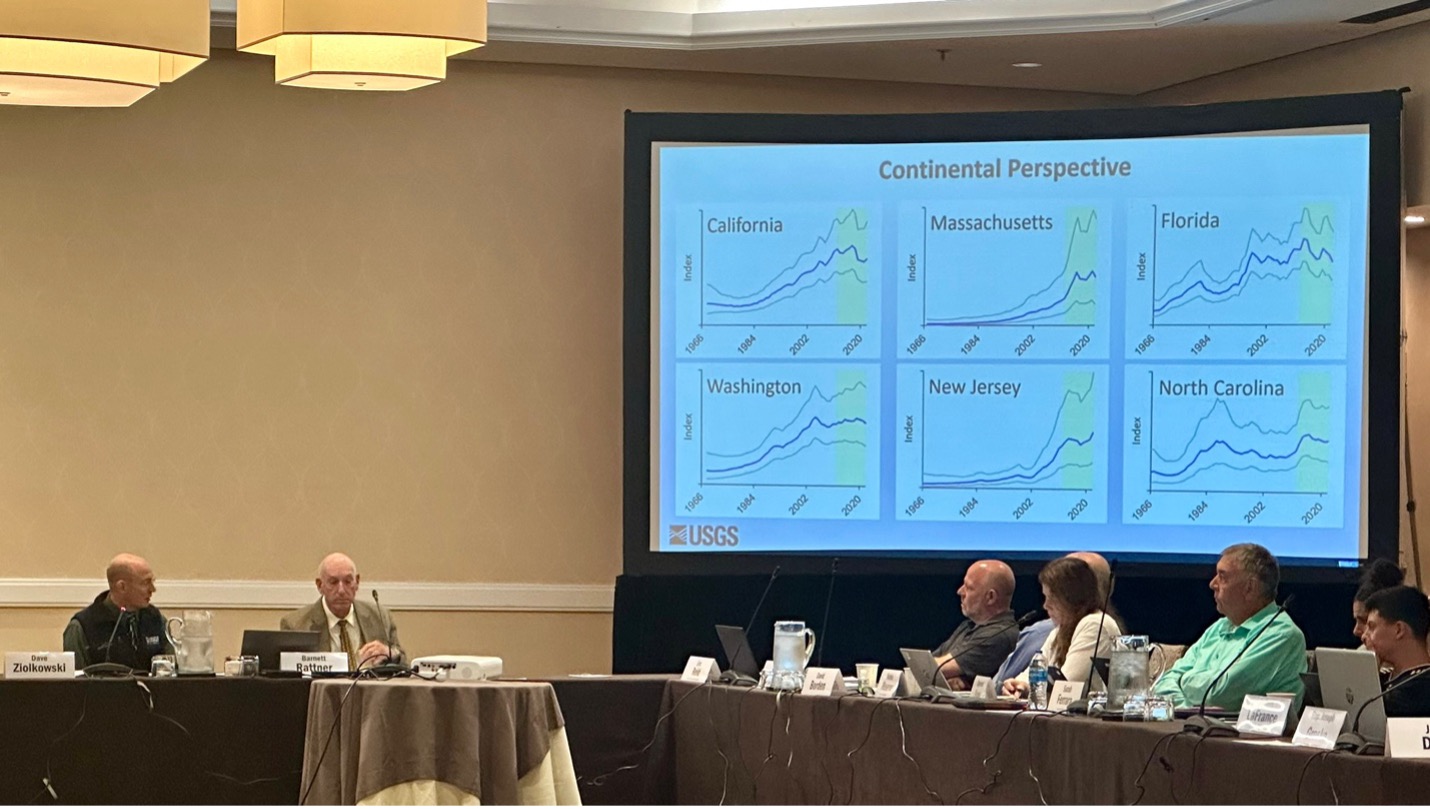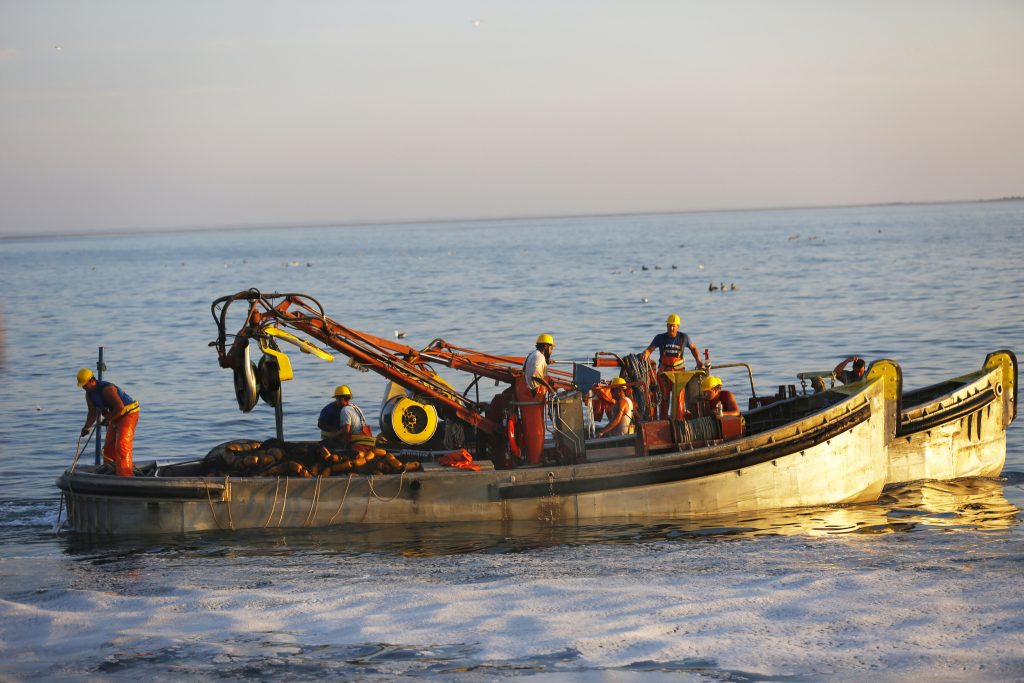August 6, 2024 — The following was released by the Menhaden Fisheries Coalition:
Today at the Atlantic States Marine Fisheries Commission (ASMFC) summer meeting, the Menhaden Management Board heard a presentation on osprey populations from U.S. Geological Survey (USGS) scientists; considered but did not agree to a motion to start an addendum on additional commercial menhaden fishing restrictions in the Chesapeake Bay; and ultimately agreed, as a compromise, to create a working group to “consider and evaluate options for further precautionary management of Chesapeake Bay menhaden fisheries.”
The Chesapeake Bay Foundation (CBF) has issued a stunningly deceptive press release, mischaracterizing the tone of today’s ASMFC meeting and the action taken there. The CBF release suggests that the material presented by USGS overwhelmingly indicated a problem with osprey in the Chesapeake Bay, and that there was overwhelming support by ASMFC commissioners for additional regulation of menhaden in the Chesapeake Bay. Neither is true. The Menhaden Fisheries Coalition is issuing this release, together with the full audio of the meeting, to clarify the record. The full audio is available here.
Dr. Barnett Rattner and David Ziolkowski of the U.S. Geological Survey gave a presentation on the health of osprey populations from coast to coast. Mr. Ziolkowski noted that “in North America in the 1950s and 60s, osprey population started declining rapidly due to the effects of volcanic chlorine, pesticides like DDT, and it’s estimated that the Chesapeake Bay probably lost about half or more of its population.”
However, Mr. Ziolkowski explained that after measures were taken, including banning DDT, between 1966 and 2022, the eastern population of osprey increased by about 300%, and the Atlantic Coast population increased by about 587%. In the Chesapeake Bay it’s increased by about 1800% since 1960. He continued, “…what these numbers bear out is that osprey have made an astounding recovery by all accounts. The numbers are now in excess of historical numbers and in part that’s because they’ve returned to a world that’s very different than the world was before they started declining. There’s more suitable nesting structures. Water may be cleaner, et cetera.”
Mr. Ziolkowski did note that during the period from 2012 to 2022, “something’s going on,” as there has been a leveling off in the growth of the osprey populations in the mid-Atlantic. But he explained, “Care must be used when you’re interpreting these kinds of results and to understand what I mean, it’s helpful to look at osprey trends across the country. So here I’ll point out three things that I hope you take notice of in these graphs. On the left-hand side here, for example, California and Washington, opposite coast, you can see that there’s something going on in the same time period as there is here in Maryland, Virginia.”

Dr. Barnett Rattner and David Ziolkowski of the U.S. Geological Survey present a slide to the Menhaden Management Board showing that the recent leveling-off in Maryland and Virginia osprey populations, after years of explosive growth, is a phenomenon also being seen in states across the nation, on both the East and West Coast.
During the Q&A following the presentation, Commissioner Patrick Geer of Virginia, Chief of Fisheries Management at the Virginia Marine Resources Commission, noted that “Dr. [Bryan] Watts has done a survey in Virginia, for a number of years, going back to I believe 1993, which has shown the double crested cormorant population has increased 1416% in 25 years and brown pelicans have been about 882%. Now those species that are primarily piscivores…they’re competing for the same food source…Maybe the [osprey] nests aren’t surviving, maybe they’re moving out and these two species are moving in? Is that possible?” To which Dr. Rattner replied “Yes, it’s possible, certainly.”
After the presentation by the USGS scientists, Commissioner Lynn Waller Fegley of Maryland, Director of Fishing and Boating Services at the Maryland Department of Natural Resources, made a motion to initiate an addendum to the Atlantic Menhaden Interstate Fishery Management Plan to consider Chesapeake Bay-specific management options for menhaden purse seine vessels larger than 300 gross tons in order to support the need of piscivorous birds and fish during critical points of their life cycle, and include options for seasonal closures of Chesapeake Bay waters, but not consider changes to the current Bay cap of 51,000 metric tons.
It became immediately apparent that the board was divided on this proposal.
The provision targeting purse seine vessels over 300 tons was obviously included to target the commercial menhaden reduction fishery, which in Virginia is operated by Ocean Harvesters and supplies menhaden to Reedville-based processer Omega Protein. This was questioned by Commissioner Proxy Eric Reid of Rhode Island, who asked if the motion wasn’t inherently flawed, since although there are carrier vessels over 300 tons, those vessels get their fish from pairs of small purse seine boats, meaning that the motion accomplished nothing. Mr. Reid’s conjecture was confirmed by a member of the delegation from Virginia.
Commissioner Proxy Nichola Meserve of Massachusetts, Fishery Policy Analyst at the Massachusetts Division of Marine Fisheries, raised concerns about “diving immediately into an addendum process,” noting that other addenda in the past began “with a work group, a board work group that discussed the issues and the concerns that developed potential strategies.
After much procedural wrangling, there were two votes to postpone action on the motion, one until the October meeting and another indefinitely. Both of those votes tied 9-9. When it became apparent that the motion to initiate an addendum had reached a stalemate, Commissioner Proxy Dr. Allison Colden, Chesapeake Bay Foundation Maryland Executive Director, offered a substitute motion “to establish a board work group to consider and evaluate options for further precautionary management of Chesapeake Bay menhaden fisheries, including time and area closures, to be protective of piscivorous birds and fish during critical points of their life cycle.
The board members accepted this compromise unanimously by acclamation, without a roll call, and the working group is expected to report the results of their discussion to the Menhaden Management Board at its October 2024 meeting.
“Those attending the ASMFC’s Menhaden Management Board meeting in person or listening online could only come away with one clear message from the respected researchers at USGS, and that is the osprey’s numbers have dramatically increased and any challenges that the seabirds face are complex and multi-faceted, occurring in numerous locations on both the Atlantic and Pacific coasts, and cannot be blamed on the menhaden harvest in the Chesapeake Bay,” stated Ben Landry, Vice President of Public Affairs for Ocean Fleet Services and spokesperson for Ocean Harvesters. “To state otherwise is wholly dishonest, but that is commonplace for the Chesapeake Bay Foundation and its decades-long history of false and hyperbolic statements on menhaden fisheries.”
The menhaden fishery has long been attacked by those who refuse to accept the science-based conclusions of respected government agencies and independent assessment bodies. However, it is important to remember that since 2020, after a three-year, peer-reviewed effort, with input from both industry and environmental conservation groups, menhaden has been managed using ecological reference points that account for menhaden’s role as a forage fish throughout its range.
When the ecological reference points were adopted, Chesapeake Bay Foundation President William C. Baker stated in a release: “This is a historic day for fisheries management. Menhaden have been called the most important fish in the sea for good reason. Menhaden are an essential part of the diet of numerous fish species including striped bass, along with dolphins, whales, osprey and other seabirds.”
In 2020, Chris Moore, Senior Regional Ecosystem Scientist for CBF, wrote in the Bay Journal, “Striped bass, of all the predators studied, were shown to be the most sensitive to changes in the menhaden population. Therefore, adopting ecological reference points that protect striped bass will also protect other predator species that rely less on menhaden.”
Additionally:
- In 2022, the Atlantic States Marine Fisheries Commission concluded there was no evidence that menhaden were being overfished along the Atlantic coast.
- The Marine Stewardship Council in 2019 certified the Atlantic menhaden fishery as sustainable.
About the Menhaden Fisheries Coalition
The Menhaden Fisheries Coalition (MFC) is a collective of menhaden fishermen, related businesses, and supporting industries. Comprised of businesses along the Atlantic and Gulf coasts, the Menhaden Fisheries Coalition conducts media and public outreach on behalf of the menhaden industry to ensure that members of the public, media, and government are informed of important issues, events, and facts about the fishery.

